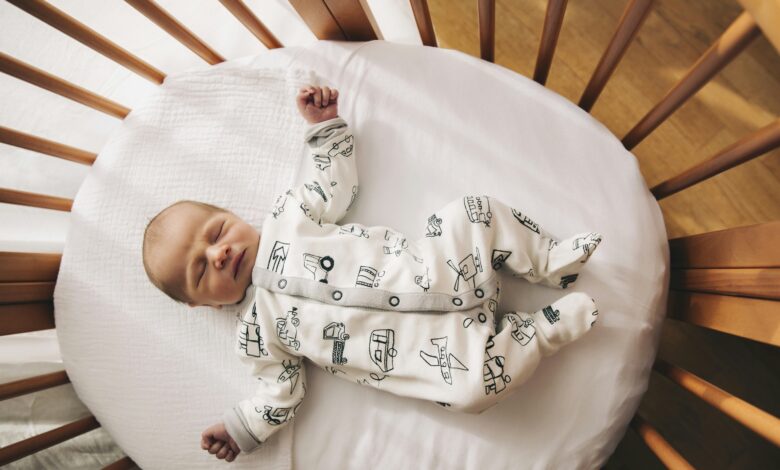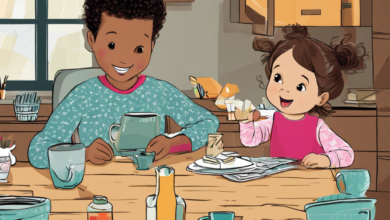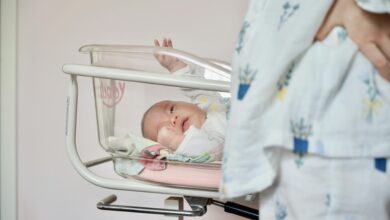
As a new parent, you might wonder, “What’s the best room temperature for my newborn?” It’s a question that seems simple but is crucial for your baby’s comfort and health. Let’s explore how to create the perfect cozy space for your little one.
Key Takeaways
- The recommended room temperature for newborns is between 68-72°F (20-22°C).
- Maintaining the ideal temperature helps regulate a newborn’s body temperature and promotes comfortable sleep.
- Proper clothing and bedding can also impact the optimal temperature for a newborn’s room.
- Understanding the signs of overheating or being too cold is crucial for a newborn’s safety and health.
- Investing in a nursery with proper ventilation and temperature control can create a soothing environment for your little one.
Understanding Ideal Room Temperature for Newborns
Keeping the right room temperature is key for a newborn’s health and comfort. It helps prevent the dangers of being too hot or too cold. This includes the risk of Sudden Infant Death Syndrome (SIDS). By keeping the nursery at the right temperature, parents can make a safe place for their baby to sleep, eat, and grow.
Importance of Proper Room Temperature
Being too hot can make a baby irritable, breathe fast, and even cause heat stroke. Being too cold can make them sleepy, unresponsive, and lead to hypothermia. Newborns can’t control their body temperature well yet. So, it’s important to keep the room at a comfortable temperature to help them stay healthy and safe.
“Newborns are especially vulnerable to temperature fluctuations because their bodies are still developing the ability to regulate their own temperature.”
The best room temperature for newborns is between 68°F and 72°F (20°C and 22°C). This keeps the baby’s body temperature stable and lowers the risk of overheating or hypothermia. By watching the nursery’s temperature and adjusting it when needed, parents can make a safe and calm space for their baby.
Keeping the right temperature is crucial for a newborn’s health and happiness. By knowing how important it is to keep the room at the ideal temperature, parents can help their baby stay comfortable and avoid the dangers of being too hot or too cold.
Recommended Room Temperature Range
Temperature is key for a newborn’s comfort and safety. The American Academy of Pediatrics suggests keeping the nursery at 68-72°F (20-22°C). This range helps the baby stay comfortable without getting too hot or cold.
Parents can check the nursery’s temperature with a room thermometer. They should adjust the thermostat as needed. The ideal temperature might change based on the baby’s age, health, and needs.
“Maintaining the proper ideal room temperature is essential for a newborn’s comfort and well-being. It helps them to regulate their body temperature and prevents the risks associated with overheating or being too cold.”
Keeping the temperature range right creates a cozy space for your baby. This supports their healthy growth and makes them happy.
Every baby is different, so watch how they react to the temperature. With some trial and error, you’ll find the thermostat setting that keeps your baby happy all day and night.
Newborn’s Temperature Regulation
Keeping a newborn’s body temperature right is key for their health and comfort. Newborns can’t control their temperature well, so they easily feel the changes in their surroundings. Knowing how to keep their temperature stable and check it is important for their health.
Monitoring Baby’s Temperature
The best way to check a newborn’s temperature is with a rectal thermometer. This method gives the most accurate reading, showing the core body temperature. Newborns should have a temperature between 98-100.3°F (36.7-37.9°C). If a baby’s temperature goes over 100.4°F (38°C), it might mean they have a fever and need a doctor.
It’s important to check a newborn’s temperature often because they can get too hot or cold easily. Parents should watch their baby’s temperature closely, especially if they seem not right. This way, parents can spot any big changes and get help if needed.
| Temperature Range | Interpretation |
|---|---|
| 98-100.3°F (36.7-37.9°C) | Normal body temperature for newborns |
| Above 100.4°F (38°C) | Fever, indicating a possible illness or infection |
Keeping a newborn in a comfy and stable place is very important for them. By knowing how to keep their temperature right and checking it often, parents can make sure their baby is safe and happy.
Signs of Overheating or Being Too Cold
It’s important to know the signs of overheating or being too cold in newborns. By watching for certain signs, parents can keep their babies safe and comfortable.
Signs of Overheating
Signs that a newborn might be overheating include sweating, flushed cheeks, fast breathing, and clammy skin. These signs mean the baby is too warm. They also raise the risk of SIDS (Sudden Infant Death Syndrome).
Signs of Being Too Cold
Signs that a newborn is too cold include cool skin on the hands and feet, being very sleepy, and crying a lot. Babies who are not dressed warmly or in a cold room may have trouble keeping their body temperature right. This could lead to hypothermia.
Knowing the signs of overheating or being too cold lets parents quickly fix the baby’s environment. This keeps them comfortable and healthy.

“Paying close attention to visual cues can help parents make adjustments to ensure their newborn’s comfort and safety.”
Dressing and Bedding Considerations
Finding the right balance of comfort and safety is key when dressing and outfitting a newborn’s nursery. Babies should wear one more layer than adults in the same space to keep the room at the right temperature. Lightweight, breathable fabrics like cotton are perfect for clothes and bedding. They help keep a newborn’s body temperature steady.
Layering and Lightweight Fabrics
Layering is crucial when dressing a newborn. Baby clothing, sleep sacks, and swaddles help keep a little one cozy and happy. Sleep sacks are especially useful, offering warmth without the dangers of loose blankets during sleep.
Choose lightweight, temperature-regulating materials like cotton for fabrics. Stay away from heavy, bulky layers that could make a baby too hot. Knowing about TOG (Thermal Overall Grade) ratings helps parents pick the right sleepwear and blankets for the nursery’s temperature.
Using proper layering and lightweight, breathable fabrics ensures a newborn’s comfort and safety all day and night. Dressing and setting up the nursery with temperature control in mind makes a cozy, safe space for your baby to grow.
| Fabric Type | Benefits for Newborns |
|---|---|
| Cotton | Breathable, lightweight, and temperature-regulating |
| Swaddling Blankets | Provide a sense of security and comfort, while helping to regulate body temperature |
| Sleep Sacks | Offer warmth without the risk of loose blankets, promoting safe sleep |
“Proper layering and the use of lightweight, breathable fabrics can ensure a newborn’s comfort and safety throughout the day and night.”
Conclusion
Keeping the perfect room temperature for newborns is like an art. It should be between 68-72°F (20-22°C). This creates a cozy space that helps with newborn care, temperature regulation, and overall health. It’s important to keep the room at this ideal temperature to prevent SIDS and ensure your baby’s comfort.
It’s key to know when your baby is too hot or cold. Dressing them in the right layers and using lightweight fabrics helps. With these tips, you’ll create a great environment for your baby to sleep well and thrive.
Let’s celebrate the perfect nursery temperature. It’s crucial for your baby’s comfort and health. You’re like a maestro, making sure your baby is just right in terms of temperature regulation.
FAQ
What is the ideal room temperature for a newborn?
Experts say keep a newborn’s room between 68-72°F (20-22°C). This ensures they stay comfortable, healthy, and develop well.
Why is maintaining the right room temperature crucial for a newborn?
The right temperature prevents overheating or being too cold. Overheating can make a baby irritable and lead to rapid breathing or heat stroke. Being too cold can cause a baby to be very sleepy, unresponsive, or even have hypothermia.
What is the recommended temperature range for a newborn’s room?
The American Academy of Pediatrics suggests a room temperature of 68-72°F (20-22°C) for newborns. This range is perfect for keeping them comfortable and safe. It’s not too hot or too cold, letting the baby control their body temperature well.
How can parents monitor a newborn’s temperature?
Use a rectal thermometer to check a baby’s temperature accurately. It should be between 98-100.3°F (36.7-37.9°C). A temperature over 100.4°F (38°C) might mean a fever and needs a call to the pediatrician.
What are the signs of overheating or being too cold in a newborn?
Overheating signs include sweating, flushed cheeks, fast breathing, and clammy skin. Being too cold signs are cool skin on the hands and feet, being very sleepy, and crying a lot.
How should parents dress a newborn for the appropriate room temperature?
Dress babies in one more layer than adults in the same space. Use lightweight, breathable fabrics like cotton for clothes and bedding. Sleep sacks and swaddles help keep a baby’s temperature right. But, always follow safe sleep rules and avoid overheating.




